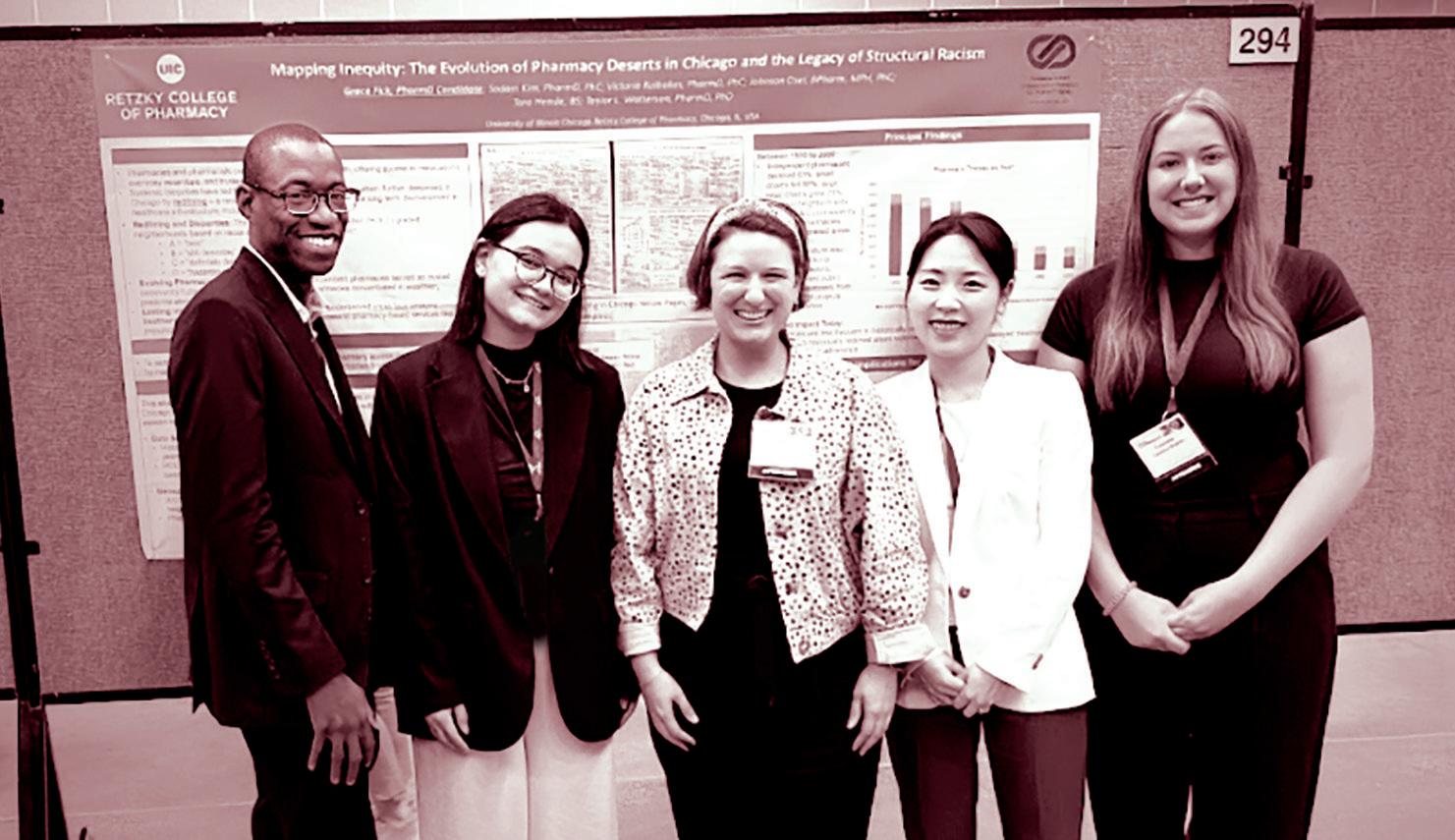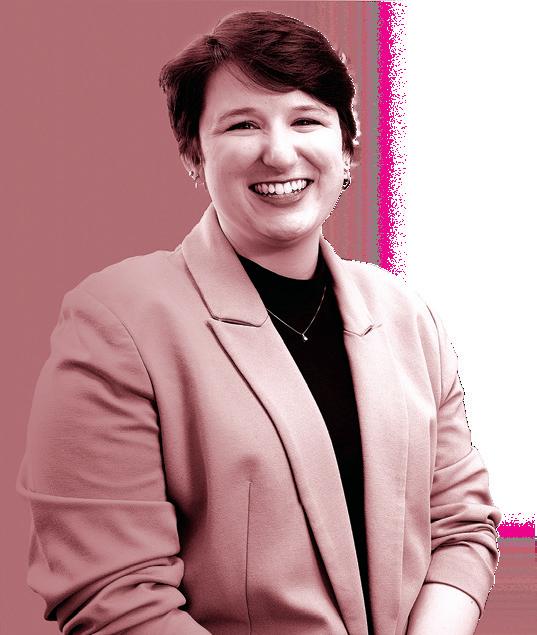
8 minute read
Exhausted
EXHAUSTED: PROTECTING PATIENTS BY REDUCING OCCUPATIONAL FATIGUE IN PHARMACY WORKERS
Taylor Watterson was earning her PharmD in 2015 when she drove to her job as a pharmacy technician, parked her car, and cried. “I was overcome with anxiety and dread before every shift,” says Watterson, now an Assistant Professor of Pharmacy Systems, Outcomes and Policy at the UIC Retzky College of Pharmacy.
As a kid, Watterson dreamed of being a community pharmacist. However, she found the work as a pharm tech exhausting, and she was terrified of making a mistake that might hurt a patient. The experience inspired a career shift. Today, Watterson is Principal Investigator at the UIC Systems-based Collaborative Research for PatienT Safety (SCRPTS) Lab, where she and her team explore ways to enhance patient safety by supporting healthcare workers and making their workplaces better.

Much of the SCRPTS Lab’s research focuses on occupational fatigue in community pharmacy settings. Community pharmacists and pharmacy technicians often work long hours, including evenings and weekends, and have a unique relationship with their patients.
“Pharmacists and pharm techs provide medical care, but they also swipe your credit card,” says Watterson. “That dual role—healthcare professional and customer service provider— creates additional tension that compounds occupational fatigue.”
Fatigue in community pharmacies can have dire downstream effects for employees, patient safety, and employers’ bottom lines, says Watterson. National data shows that healthcare workers who are fatigued are more likely to take short-cuts that put patient safety at risk, call in sick, or even get into a car accident after work.
UNDERSTANDING OCCUPATIONAL FATIGUE VS. BURNOUT
Experts distinguish between occupational fatigue and burnout. Occupational fatigue results from an
imbalance between the demands of work and the capacity and tools to do it. The fatigue can be acute or chronic, and its symptoms can be mental or physical.
imbalance between the demands of work and the capacity and tools to do it. The fatigue can be acute or chronic, and its symptoms can be mental or physical.
“People experience fatigue in lots of ways,” says Watterson. “Mentally, they may feel drained or stressed out. Physically, they may be tired, experience eye strain, or have aches and pains—for example, they may have sore feet from standing all day.” Whether symptoms are physical, mental, or both, occupational fatigue prevents people from working at their full potential.
Approximately 7 out of 10 community pharmacists say their workload levels are too high, and 4 out of 10 said their workload negatively affected the quality of care they are able to provide.
When occupational fatigue becomes chronic, it can lead to job dissatisfaction and burnout. Watterson describes burnout as a misfit between the employee and the job. “Someone who is burned out is not going to come back from vacation feeling refreshed and ready to work. Burnout can cause people to quit their job or change careers.”
Research suggests anywhere between 5% and 75% of pharmacists experience burnout. Losing employees, Watterson points out, costs pharmacy owners money: “It’s expensive and time consuming to replace highly trained, licensed professionals. There is a very real, monetary incentive for employers to try and prevent occupational fatigue.”
A SYSTEMIC PROBLEM, NOT INDIVIDUAL WEAKNESS
The SCRPTS Lab surveys pharmacists and pharmacy technicians about their work experiences. In one small study, 50% of pharmacy technicians reported acute fatigue and 30% reported chronic fatigue. Those results support a larger body of research that shows occupational fatigue is widespread.

“It’s not a matter of pharmacy techs needing to be more resilient or developing thicker skin,” says Grace Fick, PharmD candidate and research assistant in the SCRPTS Lab.
Fick, who has worked as a pharmacy technician herself, says systemic problems can be especially apparent in lower income or underserved areas.
“People who live in those areas tend to have healthcare access issues that require extra time at the counter,” she says. For example, a patient’s medication may cost more in January than it did in December, and they may be upset by the unexpected price jump. “You have to explain how insurance deductibles work and possibly help them figure out a solution so they can get the medications they need. That’s an important part of the job.”
She goes on, “But while you’re spending time with that person, you can see that other patients are lining up, and they’re getting annoyed because they have to wait. And while all that’s happening, you know you’re falling behind on the management’s daily quota for prescriptions filled per day.”
Pharmacy workers who fall behind on quotas may feel pressure to skip scheduled breaks. Skipping breaks, along with feelings of frustration and powerlessness, contribute to occupational fatigue.
FRAMEWORKS FOR LOOKING AT FATIGUE
Like most research teams, Watterson and her staff invest a lot of time into data analysis and interpretation. However, unlike laboratory researchers, the SCRPTS team focuses on obtaining, coding, and analyzing survey responses and other social science data. To do so, they use framework models, such as the Conceptual Framework of Occupational Fatigue.
“Occupational fatigue has so many possible root causes and potential outcomes. We need framework models to make sense of things,” says Watterson.
A framework helps examine individual and work system factors that may lead to occupational fatigue. It can also help predict how fatigue will affect employees’ wellbeing, patient safety, and organizational outcomes.
Practical Strategies for Reducing Occupational Fatigue
While working shorter shifts is one way to reduce occupational fatigue, the SCRPTS Lab research shows cutting hours isn’t the only option.
Scheduling employees for the days and times that work best for them is one tactic, says Watterson. “For example, a pharmacy student may prefer to work weekends, when they don’t have classes, while a pharmacist with a toddler may prefer to work evenings when their partner can be home.”
10 community pharmacists say their workload levels are too high, and 4 out of 10 said their workload negatively affected the quality of care they are able to provide.
Having a pharmacist available when someone is too tired to work safely can prevent dangerous situations. "Having a staff pharmacist on call may be preferable to using 'pro re nata' (PRN) pharmacists who may be unfamiliar with and less invested in that community pharmacy," Watterson explains.
Changes to ergonomics, such as adjustments to workstation configuration, lighting, and available seating, can pay big dividends. So can fostering a supportive work culture, says Johnson Osei, a PhD student and graduate research assistant in the SCRPTS Lab. Osei has worked as both a pharmacy technician and pharmacy manager, and he says his work experience is consistent with research findings.
“Even in difficult working conditions there can be a culture of support and encouragement among the team,” he says. “For example, a pharmacy manager may stand up for a pharm tech being disrespected by a customer or they may offer to take over and give that pharm tech a break.”
Of course, clinical pharmacists can help guard against occupational fatigue by being selective about which pharmacies they choose to work for. “While it can be tempting to take that $100,000 signing bonus, it’s a good idea to stop and ask questions about the work conditions. What might you be sacrificing in terms of quality of life and future well-being?” asks Watterson.
HOW PATIENTS CAN HELP
Watterson says that patients can play an important role in reducing occupational fatigue by choosing pharmacies that prioritize employees’ well-being.
For example, if the pharmacy doesn’t close for lunch, customers can ask if the staff get mandatory lunch breaks. Patients should also look around the pharmacy. “Are there signs requesting their patience or warning that there’s zero-tolerance for harmful customer behavior? Do they display staff awards and certifications? Do employees look comfortable—do they have a place to sit if they need to?”
Patients can also take note of staff turnover. “Are you seeing the same faces behind the counter at every visit? If they've been there a while, there's likely a good reason,” says Watterson.
Perhaps most importantly, patients be kind and respectful to the pharmacists and pharmacy technicians who serve them. “Remember, they started their career because they wanted to help people, and they are doing their best. There are a lot of things out of their control, like medications on backorder and insurance authorizations,” Watterson advises.
LOOKING FORWARD: ONGOING RESEARCH AND IMPACT
The SCRPTS Lab team hopes their ongoing work will continue to build a strong case for preventing occupational fatigue and encourage community pharmacies to make changes that support employee well-being.
In June, members of the SCRPTS Lab presented some of their research findings at the poster session of the Academy Health Annual Research Meeting, held in Minnesota. The team also authored a literature review article that will be published in the SeptemberOctober issue of The Journal of the American Pharmacists Association.
Thanks to a $50,000 grant from the Retzky College of Pharmacy’s Hans W. Vahlteich Research Award, the SCRPTS Lab will soon begin an examination of occupational fatigue as it relates to using electronic health records. The hope is to gain insights that will help reduce both occupational fatigue and the data entry errors that fatigue may cause.
Explains Osei, “It’s important we do everything we can to optimize patient care and outcomes, and in order to do that, we need healthcare providers to be in great shape.”

